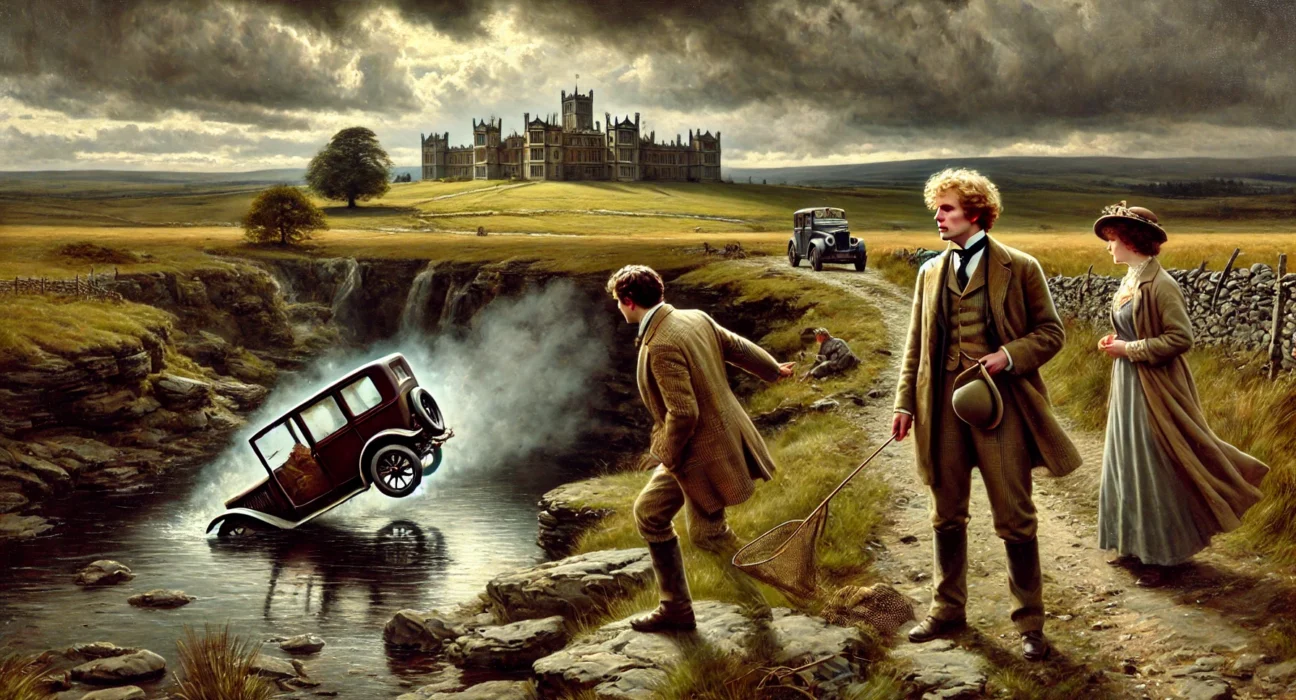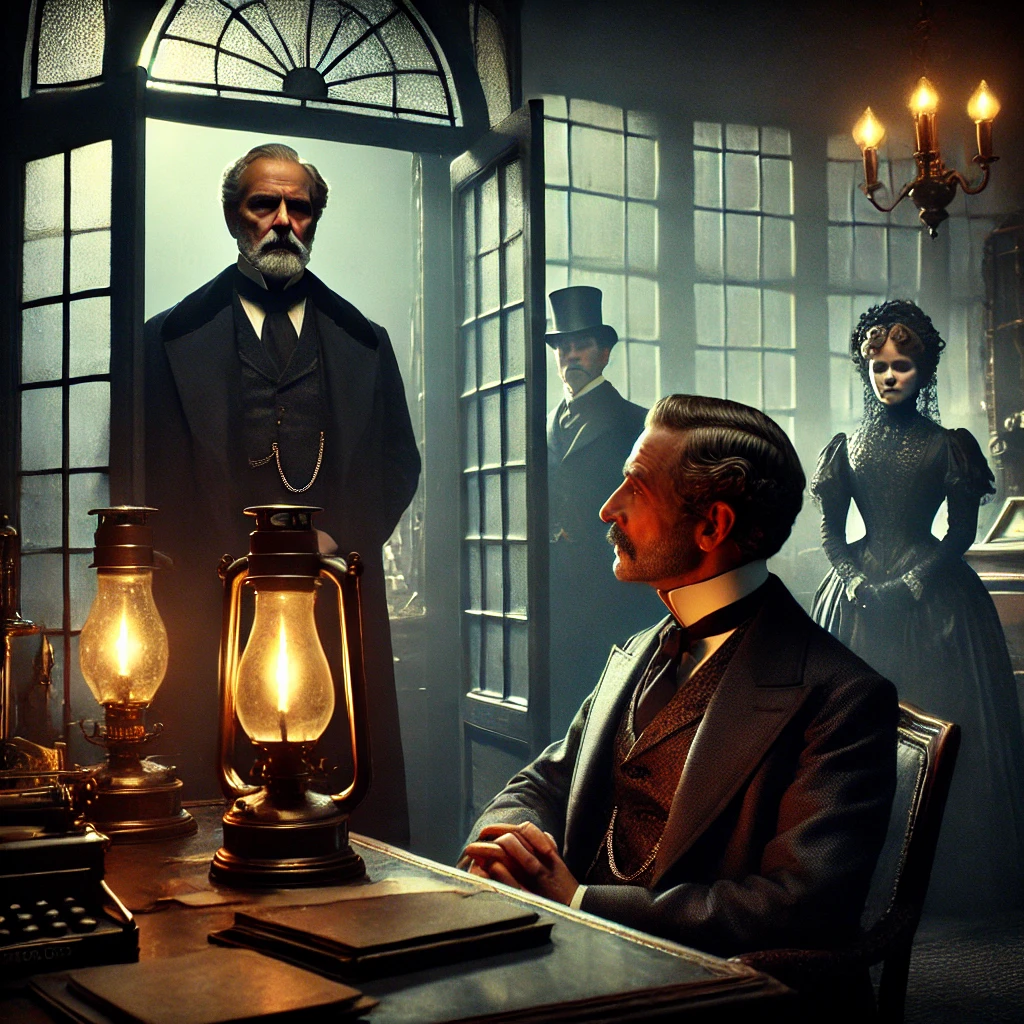The Man Who Knew Too Much by G.K. Chesterton, published in 1922, is a collection of eight detective stories featuring the enigmatic Horne Fisher. The tales revolve around Fisher’s exceptional ability to solve mysteries by drawing on his deep knowledge of human nature, society, and politics. Fisher’s insight often leads him to uncover unsettling truths, reflecting Chesterton’s fascination with paradox and irony. The stories blend mystery with a broader commentary on power, morality, and the complexities of political life.
Plot Summary
On a bright, breezy day, Harold March walked across the sprawling Torwood Park, heading for an interview with the esteemed Chancellor, Sir Howard Horne. March, a promising young journalist, was eager to delve into the intricacies of the Chancellor’s latest budget. Yet, on this sunlit walk, he found himself in the strangest encounter of his life. Near a small stream, he met a tall, fair man with a net, more interested in scooping up mud and small fish than catching anything of real value. This was Horne Fisher, a cousin of Sir Howard and a man who, as March would soon discover, knew too much about everything.
As they conversed, a terrifying sound interrupted them—a motorcar crashing off the rocky edge nearby. Together, they rushed to the scene, only to find the wreckage of the car and the body of Sir Humphrey Turnbull, a prominent politician. The cause of death was a fractured skull, but Fisher, ever the observant mind, noticed something more sinister. He deduced that Turnbull had been shot before the crash, and the accident was merely a cover-up for murder. March was astounded by Fisher’s calm detachment as he unraveled the crime, but Fisher merely shrugged, muttering about the things he had learned that made life both simpler and more tragic.
As the days passed, March found himself in Fisher’s company more often, each time drawn into a new mystery. There was the case of Prince Michael, a bold Irish nationalist who was always one step ahead of the law. Fisher, with his keen understanding of politics and human behavior, tracked the elusive prince to a remote tower on the moors. Surrounded by police, the prince fought back with unexpected force, killing several officers before vanishing from the tower. Despite the violence, Fisher admired the prince’s cunning. He knew that in the tangled web of Irish politics, truth was often as elusive as the man they sought.
Another encounter took them to a grand estate where a wealthy philanthropist, Jenkins, was hosting a shooting party. Jenkins, though rich, was known for being a poor shot. But as the day wore on, Fisher’s eye caught something unusual—the marks on an old target, scattered but precise. It was as if someone had been practicing not to miss but to appear as though they could. That evening, during a macabre joke where luminous paint was used to illuminate a caricature on the target, Fisher’s suspicions were confirmed. Jenkins had used his apparent incompetence as a cover to murder Sir Humphrey Turnbull. The poor shooting was no accident—it was the perfect disguise for a master marksman.
Each case Fisher took on seemed to reveal not just the truth behind a crime but the broader, darker realities of society. In one such instance, a quiet village was thrown into chaos by the arrival of a foreign dignitary, who had fallen in love with a local woman. Fisher’s investigation into a poisoning at the village revealed the political machinations behind the scenes, where alliances and betrayals went hand in hand. The dignitary, though charming, had many enemies, and the woman, caught between love and duty, became a pawn in a much larger game. As always, Fisher saw through the layers of deceit with his piercing intellect, but the knowledge came at a cost. He knew that solving the crime would not heal the deeper wounds of political treachery.
At times, Fisher’s work led him into the highest echelons of society, where powerful men played dangerous games. One such case involved the mysterious death of Sir Howard Horne’s closest advisor. The man was found dead in his study, a locked room with no apparent signs of entry. As March watched Fisher survey the scene, he marveled at how Fisher’s mind worked, connecting details that seemed irrelevant at first glance. In the end, it was not a grand conspiracy or a clever plot that led to the man’s demise but rather the most human of flaws—jealousy. Fisher revealed that the man’s wife had been driven to murder, unable to bear the thought of her husband’s infidelity. Once again, the resolution of the mystery brought no sense of victory, only a somber reflection on the fragility of human relationships.
As these adventures unfolded, March began to see Fisher not as the detached, all-knowing figure he first appeared to be, but as a man burdened by his understanding of the world. Fisher’s knowledge was both his gift and his curse. He could see through the lies and deception that clouded every case, but he also knew that justice, as society defined it, was rarely possible. The criminals he exposed were often the same people who controlled the levers of power. Arresting them would only lead to further corruption, more lies, and deeper injustices.
In the end, Fisher’s greatest skill was not his ability to solve crimes but his acceptance of the limits of his power. He knew that his role was not to change the world but to navigate its complexities with a clear eye and a steady hand. When asked why he continued to work on these cases, knowing that true justice was impossible, Fisher simply replied, “Because someone has to throw back the big fish.”
Through his journeys with Fisher, March learned a painful truth—that knowing too much could be as paralyzing as knowing too little. And as he parted ways with the man who knew too much, March felt both enlightened and burdened by the weight of that knowledge.
Main Characters
Horne Fisher – The protagonist, a brilliant yet melancholy man with an unparalleled insight into human nature and politics. Fisher is known for his knowledge of high society and the secrets it hides. Though he is highly intelligent and skilled at solving mysteries, his deep understanding often leaves him disillusioned and cynical about the possibility of true justice.
Harold March – A journalist and Fisher’s frequent companion, Harold represents the idealistic observer who is initially naive about the undercurrents of corruption within society. As he follows Fisher through various investigations, he gains a deeper, and often darker, understanding of the world.
Sir Howard Horne – Fisher’s cousin and a prominent political figure. Sir Howard’s political actions are at the heart of some of the mysteries Fisher untangles, revealing the ethical compromises of those in power.
Theme
Knowledge vs. Power – The title reflects the central theme of the stories: possessing too much knowledge, particularly about politics and human nature, can be both a gift and a curse. Fisher’s vast knowledge often leads to a sense of helplessness, as he is aware of the complexities and compromises behind every mystery he solves.
Corruption of Authority – Throughout the stories, Chesterton explores the theme of corruption within the political system. Many of the mysteries Fisher solves reveal a dark side to those in power, showcasing a world where justice is often subverted by personal or political interests.
The Inevitability of Injustice – Despite Fisher’s success in solving cases, there is often a sense of futility in achieving true justice. Fisher knows too much about the compromises and moral grey areas in society to believe that uncovering the truth will lead to genuine change.
Irony and Paradox – Chesterton, often called the “prince of paradox,” uses irony as a tool to critique society. Fisher, a man who can solve any mystery, is rendered powerless in the face of systemic corruption and moral ambiguity.
Writing Style and Tone
Chesterton’s writing is characterized by his sharp wit, paradoxical observations, and philosophical depth. He employs a rich, almost poetic style, filled with irony and metaphor, to explore complex ideas about politics, society, and human nature. His use of dialogue is both lively and profound, often allowing characters to express Chesterton’s own views on justice, morality, and the flaws of modern society.
The tone of The Man Who Knew Too Much shifts between light-hearted wit and a deeper, more somber reflection on the nature of power and corruption. While there are moments of humor, particularly in Fisher’s sardonic comments, the stories carry a weightier message about the cost of knowledge and the inherent imperfection of human systems. Fisher’s insight brings clarity to the mysteries but also reveals the tragic impossibility of achieving true justice in a flawed world.
We hope this summary has sparked your interest and would appreciate you following Celsius 233 on social media:
There’s a treasure trove of other fascinating book summaries waiting for you. Check out our collection of stories that inspire, thrill, and provoke thought, just like this one by checking out the Book Shelf or the Library
Remember, while our summaries capture the essence, they can never replace the full experience of reading the book. If this summary intrigued you, consider diving into the complete story – buy the book and immerse yourself in the author’s original work.
If you want to request a book summary, click here.
When Saurabh is not working/watching football/reading books/traveling, you can reach him via Twitter/X, LinkedIn, or Threads
Restart reading!








